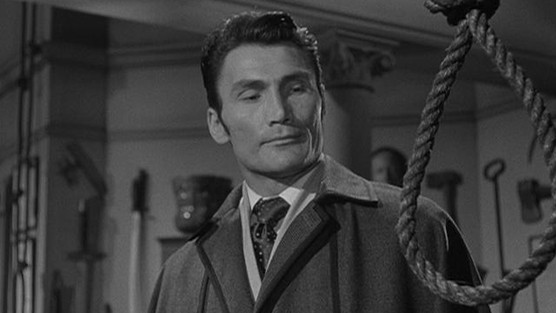It can be difficult to fit into a short screening intro all the fascinating details our Research Associate, Mike Quintero, uncovers about the films we show — so we’ll be sharing some of his raw research notes here on the blog, in no particular order and without much editing, because it seems a shame to keep them to ourselves. Thanks Mike!
This week’s research notes are about: SUDDEN FEAR (David Miller, 1952), screened on June 22th, 2022 in a 35mm print from our collection as part of CFS Season 28.
★ Taglines ★
“I Was Made To Live For Him! … / To Die For Him! … / But Now I Could Kill Him!”
“Is This The Man I Married? / The shock of truth … / The dread of murder … / The hope of revenge … / HEARTBREAK …. poised on a trigger of terror!”
“Her One Love Shattered — / Her Rival Laughing — / Her Life in Danger — / SHE KNEW WHAT SHE HAD TO DO!”
“HEARTBREAK .. POISED ON A TRIGGER OF TERROR / … She faced the threat of murder in her husband’s heart … behind her back the other woman laughed! / A Thrilling New High in Suspense and Excitement!”
“No One Will Be Seated During Last 7 Minutes of Picture. You’ll Never Guess The Finish!”
“The Shock Drama of the Year! / 2nd Record-Breaking Week!”
SUDDEN FEAR was popular enough that at least two films referred to it in their advertising campaigns:
THE STEEL TRAP (Joseph Cotten, Teresa Wright):
“To those who enjoyed ‘SUDDEN FEAR’ we promise another high-tension SUSPENSE adventure!“
“Loew’s State started a city-wide sensation when it introduced to Broadway that masterpiece of suspense — ‘Sudden Fear.’ We thought it would be years before another picture with such tense, taut suspense would come along. But much to our surprise, and, probably yours, too, here is another movie with suspense that pulls the nerves tight; that will hold you in a grip of steel anticipation … This, we promise you who enjoyed ‘Sudden Fear’, is another rare, pleasantly exciting journey into suspense.”
TORCH SONG (Joan Crawford, Michael Wilding):
“Joan Crawford makes pictures that make talk! Choosing her own stories, daring to play roles that other stars won’t touch, lovely Joan Crawford electrifies audiences with great performances in great pictures …. / Remember her in ‘Sudden Fear’? This was her most recent success and now she has topped even that startling portrayal with a movie even more unusual … / See her in ‘Torch Song’! It’s her first appearance in Technicolor … and it’s a startling off-beat love story.“
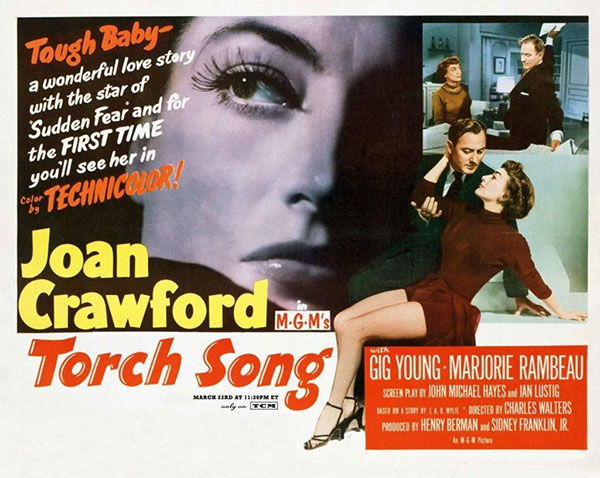
Promoting the Film
An interview in Motion Picture Daily around the time of the release of the film revealed some of independent producer Joseph Kaufman’s strategy for promoting SUDDEN FEAR. Observing that “coordination of publicity, advertising, and exploitation” requires a great deal of lead time, he noted that “plans on selling ‘Sudden Fear’ started with the writing of the script, and that took place over a year ago. Many things in the script were geared for exploitation and selling.”
As an example, he noted a sequence in the film taking place on the Western Pacific Railroad’s California Zephyr. As part of the cooperation with the railroad, the railroad furnished the equipment, and engaged in its own advertising campaign for the film, including posters and window displays for the film in its rail stations.
This publicity campaign extended to a variety of “merchandise tie-ups“: the SoundScriber recorder, for example, which acts as an important plot point.
Or Fifth Avenue Specs, whose product is worn by Crawford in the film, “based its entire summer and fall campaign” on its appearance in SUDDEN FEAR.
Or dairy in general:
“Because of a scene showing Crawford and Jack Palance drinking milk, the pressbook advised exhibitors that they should ‘find a ready tie-in with dairies, milk bars, and cafes. It will also be useful for display in youth clubs, schools, and other centers where youngsters congregate.” (from “In Theaters Everywhere: A History of the Hollywood Wide Release 1917-2017“)
This “Sudden Fear” tune by Steve Lawrence was promoted through the Mutual radio network.
There’s this ad for Rheingold Extra Dry Beer:
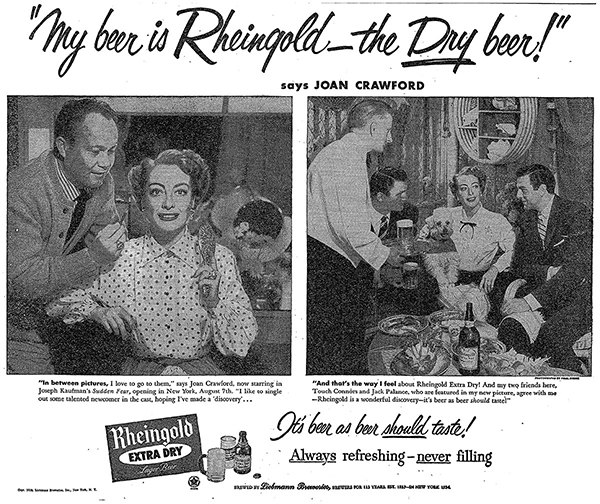
And Woodbury Cold Cream:
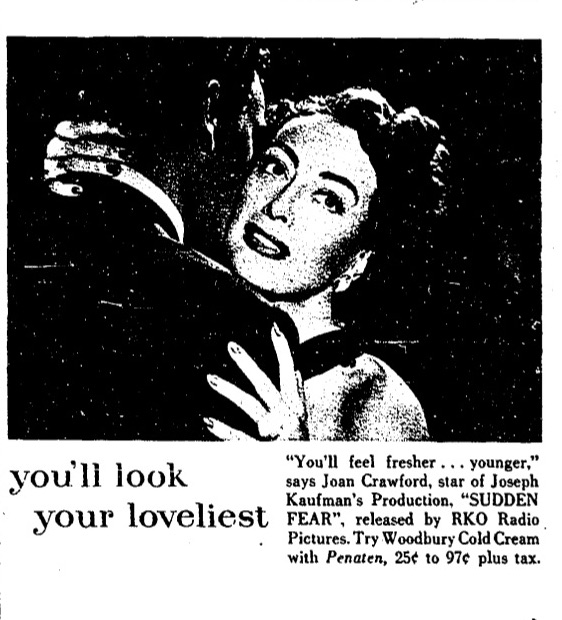
Kaufman estimated that — via these promotional arrangements — RKO’s publicity department had secured the equivalent of five million dollars of commercial advertising.
In addition, Kaufman claimed that SUDDEN FEAR would be one of the first big features to advertise on TV. Eight one-minute trailers and four 20-second trailers were made to supplement the traditional newspaper campaign.
RKO found that there was a significant difference at the box office in cities where TV promotion was used, and where it wasn’t:
“In New York, for instance, RKO plugged the movie with heavy schedules of announcements and participations on WCBS TV and WABD (total cost, about $25,000) … in its first week, it grossed $61,000, topping by far the average opening week’s gross at that theatre of $20,000 to $25,000. It ran for seven weeks, an unusually long run for the summer season.”
One exhibitor used one of those TV trailers for an in-person promotional stunt, as well:
“M. Robert Rappaport, Town, Baltimore, Md. recently came through with an extra special exploitation stunt on RKO’s ‘Sudden Fear’ by using the TV trailer for the film in a downtown shoe store window.“
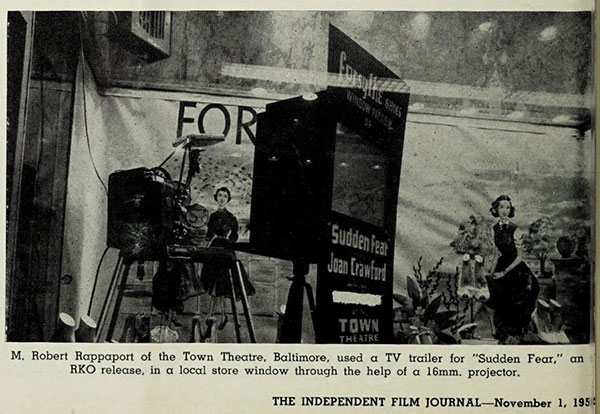
Production Notes
There’s an interesting link to THE AFRICAN QUEEN here. According to the Tribune, Joseph Kaufman had purchased the rights to C. S. Forrester’s book “The African Queen” from Warner Brothers, but ended up selling them to director John Huston (and producer Sam Spiegel), who financed the production of that film in part by signing contracts with its stars giving them relatively small salaries, but large percentages of the film’s profits.
Kaufman had subsequently purchased the rights to Edna Sherry’s novel “Sudden Fear” and, upon learning that Joan Crawford was interested in starring in the film, proposed a similar arrangement to that used to finance THE AFRICAN QUEEN. The arrangement was finalized in July of 1951, and was Crawford’s “first venture into independent production” according to the New York Times’ Thomas Brady. Walter Winchell noted that she “owned 43 percent” of the film.
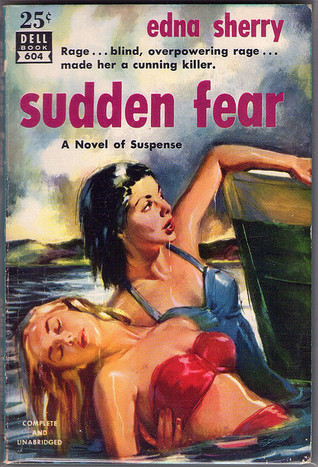
According to the New York Times, SUDDEN FEAR would be the first of a “number of top bracket films” Kaufman would release through RKO.
By March of 1952, towards the end of the SUDDEN FEAR shoot, Crawford announced that she and Kaufman were considering forming their own film company: “If our plans jell, I won’t be in any picture I co-produce. Acting is a full-time job and I don’t believe an actress can do her job if she has to split her time and energies between acting and production problems.”
Those initial proposed projects included an adaptation of Frank Stockton’s story “Lady or the Tiger” (in which Crawford would not star, but Jack Palance might) and a production of “Promised Land,” a book by former silent actress Joan Lowell detailing her adventures establishing a homestead in Brazil with her husband. Despite her previous misgivings, Crawford was announced as being “much interested in making the film version” of the book, describing it as a “rare opportunity for an actress to play the type of romantic, adventurous role which usually is only written for a man.“
None of these plans panned out, however — none of the films were made.
Even though Crawford and Kaufman were still plugging the “Promised Land” project in October of 1952, it was announced the next month that Kaufman had been hired to direct the exhibition and theatre operations of Cinerama, and that he would soon “complete plans for the opening of Cinerama theatres in three major cities.”
Even so, Hedda Hopper noted in early 1953 that Crawford and SUDDEN FEAR director David Miller were “searching like mad” for another project to do together. This wouldn’t happen until 1957, when they worked together again on THE STORY OF ESTHER COSTELLO, a 1957 film distributed by Columbia.
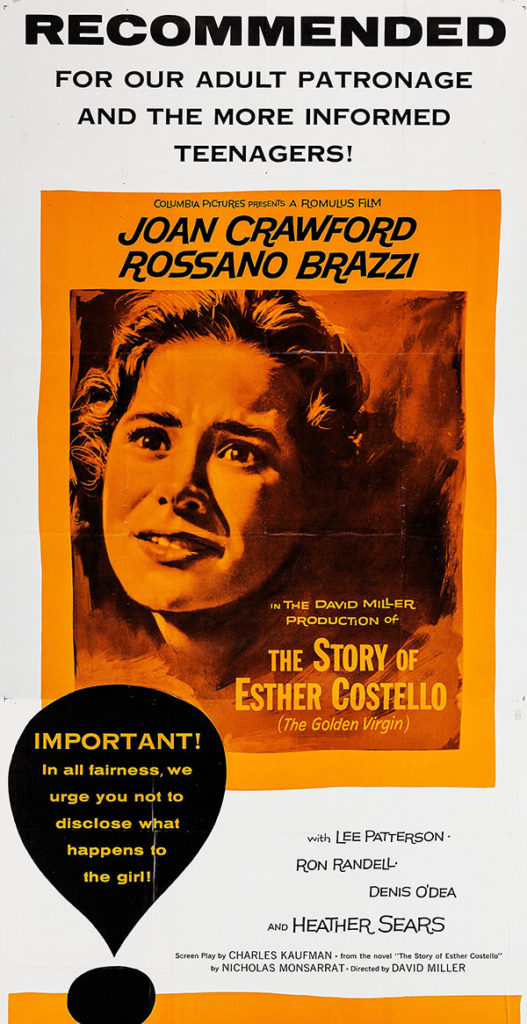
Back to SUDDEN FEAR: after the initial production deal was announced, various names were announced as attached to the film: screenwriter Lenore Coffee, Jack Palance (after Richard Egan was approached initially), Gloria Grahame, and Bruce Bennett.
(Hedda Hopper commented caustically: “Believe it or not, Jack Palance, who could play Frankenstein without makeup, is doing a romantic lead opposite Joan Crawford in ‘Sudden Fear.“)
Most surprising, and one which apparently didn’t pan out, was Stepin Fetchit, who announced that he was making his comeback (“ready to run his imitators out of town”) with this film: “And the minute the people see me … that’s all. I’ll be right back where I was in 1937. I left it good … I was on top.” He doesn’t appear in the film, though.
According to the New York Times’ Thomas M. Pryor in mid-April, the film was “coming across the finish line 23 days behind schedule“: “The delay would have been longer except for a streak of luck when the film began late last January on location in San Francisco and David Miller, the director, got in three days scenes which he had figured would take ten days.” According to Pryor, various colds and viruses among Miller, Crawford, and Grahame caused the production to lose more than 17 days.
Release
SUDDEN FEAR premiered in New York at the Loew’s State (around 3,300 seats) on August 7th, 1952, accompanied by two of its stars, according to the opening day ad: “Joan Crawford will be in Loew’s State lobby today only at 9:30 A.M. and 7 P.M. to greet her fans. Autographed photos will be distributed all day today. Jack Palance will also distribute his autographed pictures at 2 P.M.” (According to coverage in the New York Times, Gloria Grahame and director David Miller had also traveled to New York for the premiere; Hedda Hopper mentioned in her column that Miller would be “lecturing on the problems of making the film in 15 cities” as part of promoting the film.)
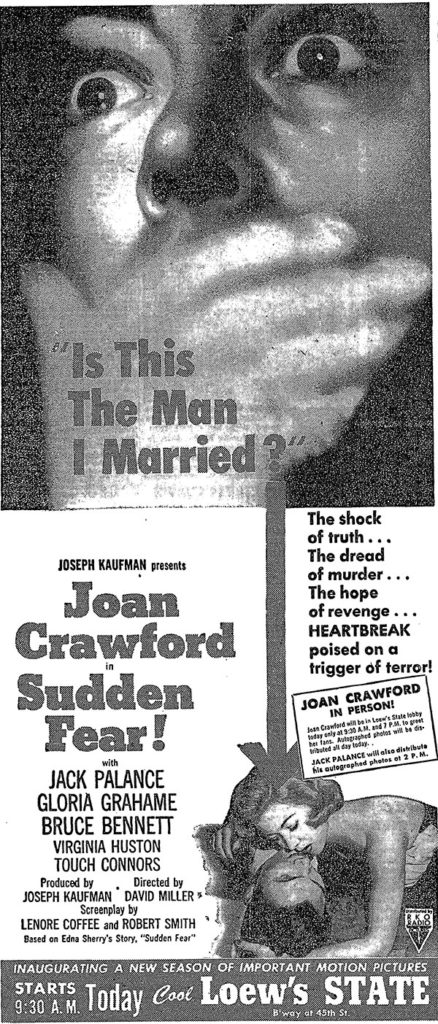
Hedda Hopper suggested this was the first time Crawford had promoted a film like this: “Joan Crawford finally did it after 20 years–made a stage appearance at the opening of ‘Sudden Fear’ in New York. She got an ovation that brought tears to her eyes.“
According to the Exhibitor, she sold tickets from the booth, too.
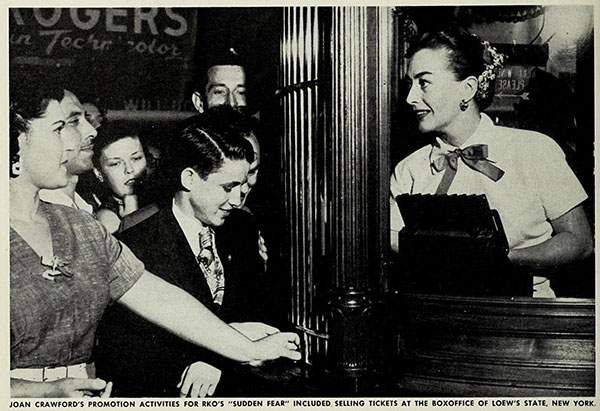
Other films in NY theaters around the same time included: Cecil B. DeMille’s GREATEST SHOW ON EARTH (also starring Gloria Grahame), Barbara Stanwyck in CLASH BY NIGHT, IVANHOE with Robert Taylor and Elizabeth Taylor, Martin and Lewis in JUMPING JACKS, and Rita Hayworth and Glenn Ford in AFFAIR IN TRINIDAD.
In DC, you could have also seen WHAT PRICE GLORY with James Cagney, or Alan Young and Dinah Shore in AARON SLICK FROM PUNKIN CRICK, described as “Paramount’s homespun heart-spinnin’ happiest musical ever — a dozen-and-one hit tunes … that are a whole hit parade in themselves!“
RKO had also launched a hundred theater revival of the 1933 KING KONG, describing it as “your mightiest screen thrill!” (It was paired with the Jacques Tourneur/Val Lewton 1943 film THE LEOPARD MAN.)
As the film’s run at the State continued, Crawford made a second in-person appearance on August 18th. (The article announcing her appearance mentions that she had recently returned from Boston — presumably after similar in-person appearances there.)
The film didn’t open in Chicago until September 11th, when it debuted at the Oriental (around 3,200 seats). According to print advertising, the first show of the day around 9 am, and the final feature screening wouldn’t start till after 11 pm (and sometimes as late as midnight, depending on the day).
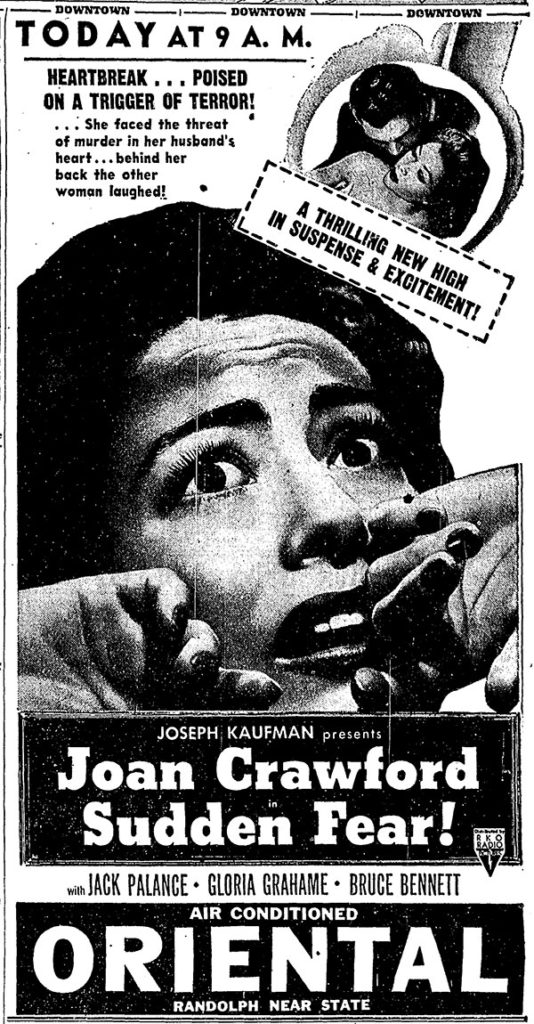
While Joan Crawford didn’t make an appearance to promote her film’s premiere in Chicago, that Thursday wasn’t completely without Hollywood sizzle — the RKO Grand advertised a “ON STAGE – IN PERSON!” appearance by “that glamorous new Hollywood star” … Bonzo.
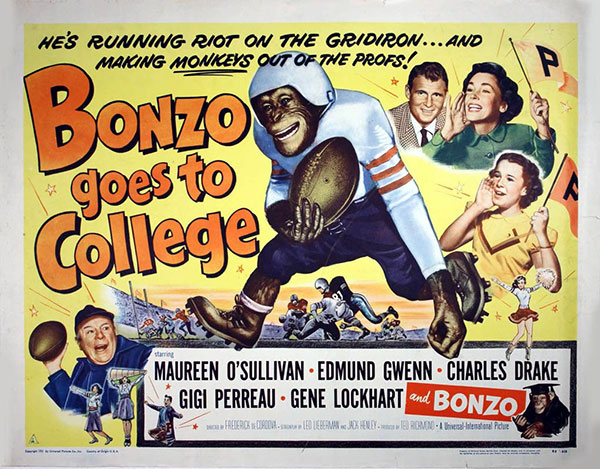
(Bonzo was, of course, the star of BONZO GOES TO COLLEGE, making its Chicago debut that day at the RKO Grand, paired as a double feature with Tony Curtis and Piper Laurie in SON OF ALI BABA.)
Other films in Chicago that week included Clifton Webb and Ginger Rogers in DREAMBOAT, Moira Shearer in TALES OF HOFFMANN, SOMEBODY LOVES ME with Betty Hutton, and THE MERRY WIDOW with Lana Turner.
Reviews
A.H. Weiler of the New York Times described the film as a “cleverly turned melodrama” which has been “mounted in excellent taste,” noting that San Francisco is an “excitingly photogenic area,” and that director David Miller has taken “full advantage of the city’s steep streets and panoramic views.”
He notes Gloria Grahame’s “excellent portrayal as the hard, brash and sexy blonde who goads our villain to desperate deeds” … but notes that “a viewer not entirely a slave to Miss Crawford’s brand of histrionics might argue that an excessive amount of footage is give to close-ups of the lady in the throes of mental traumas and other emotional disturbances. In general, however, she behaves in a convincing manner, since, after all, she is involved with a homicidal husband.“
Mae Tinee of the Tribune noted along similar lines that “Miss Crawford is — well, she’s Miss Crawford. She presents her gaunt good looks in rigid and generally expressionless fashion in the sort of role best suited to her. While there have been more deft and polished suspense tales, this one is sure to please Miss Crawford’s fans.” (And, like Weiler, she also praised Gloria Grahame’s performance.)
Bosley Crowther mentioned the film offhandedly in his review of August’s films, calling it “nobody’s ball of fire — just an average good Joan Crawford thriller” but one that was still “stacking them up at Loew’s State.”
The Washington Post’s Richard L. Coe described the film as a “slick exercise in mid-summer goosepimples,” and Crawford’s role as “something such ladies as Bette Davis or Barbara Stanwyck might well have meditated murder to have latched onto for themselves.” He also commended the “sparser-than-usual” score by Elmer Bernstein, describing him as “a man who knows the value of silence and a few piano chords.“
Awards
SUDDEN FEAR was nominated for several Oscars, including best actress (Joan Crawford) and best supporting actor (Jack Palance).
While it didn’t win any of those nominations, the attention was certainly good for Jack Palance. Hedda Hopper noted that within 24 hours of the nomination, Jack Palance had signed deals to appear in six television shows. Later that year, he was cast in a starring role for the first time (as Jack the Ripper in THE MAN IN THE ATTIC).
The Washington Post’s Richard L. Coe described Palance’s rise in fortunes this way in his November 1953 profile of Palance: “Palance crashed through to most movie-goers in Joan Crawford’s ‘Sudden Fear’, wherein he was the fortune-bent husband cagily plotting to murder the lady. After his sullen gun-toting henchman in ‘Shane’ Palance really got on the map.”
